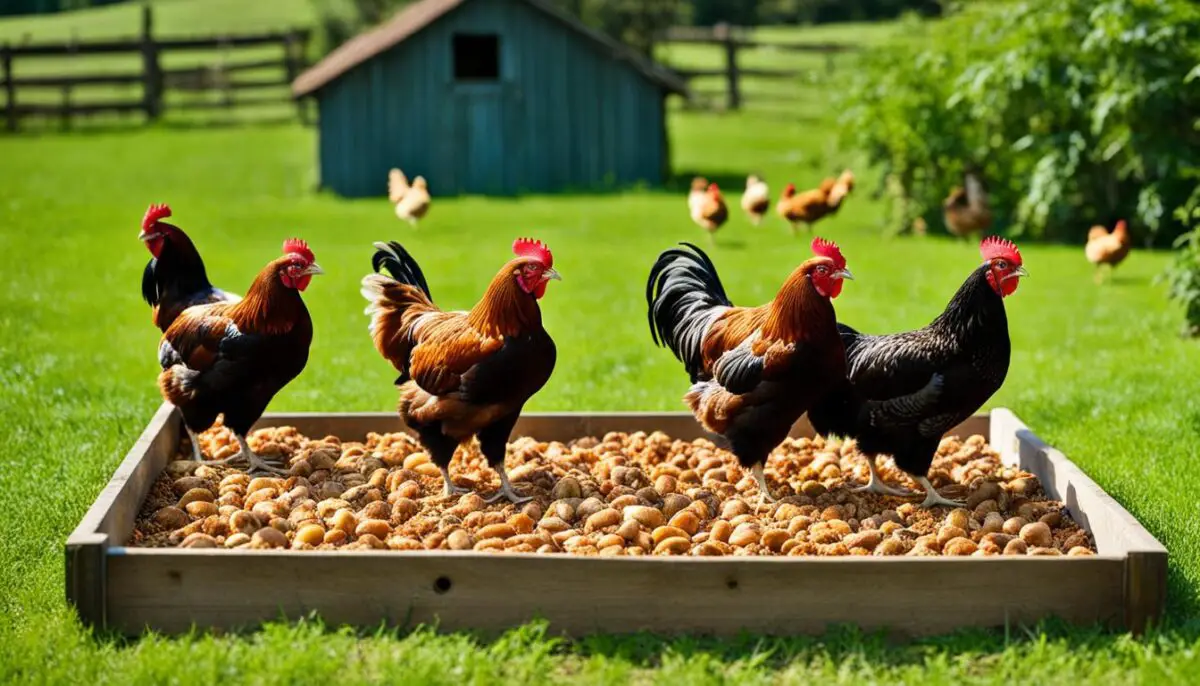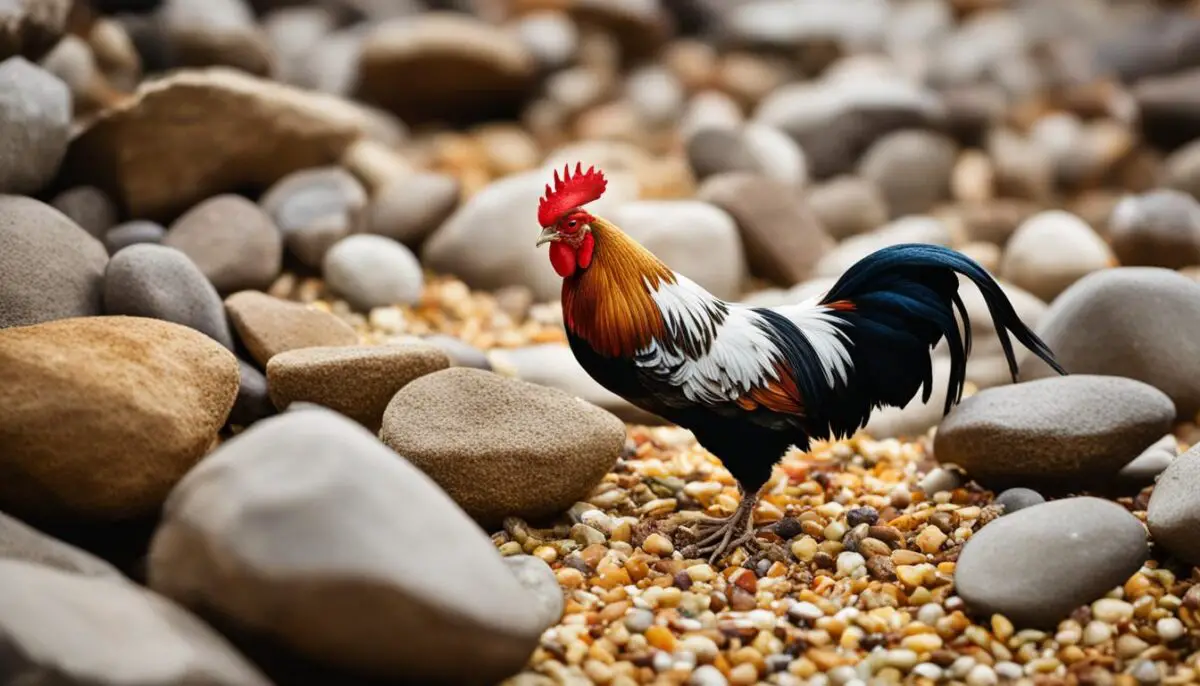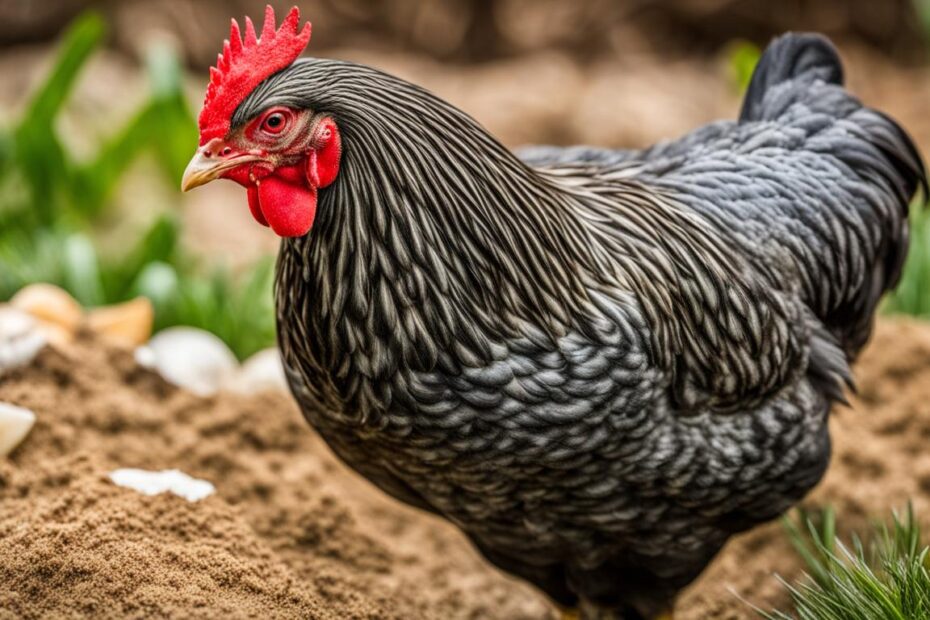Welcome to our complete guide on understanding how much grit chickens need. Grit plays a crucial role in the digestion process of chickens, ensuring that they can effectively break down their food and absorb essential nutrients. In this guide, we will explore the varying grit requirements for different poultry species, as well as the types of grit available and the benefits of providing grit to your flock. So, let’s dive in and understand how to keep your chickens healthy and thriving!
Key Takeaways:
- Grit is necessary for chickens to aid in digestion and improve overall flock health.
- Types of grit include insoluble grit for digestion and oyster shell grit for calcium supplementation in laying hens.
- Grit requirements vary depending on poultry species, age, and diet.
- Providing grit free-choice ensures chickens can consume the appropriate amount based on their needs.
- Grit intake improves feed conversion, weight gain, egg production, and overall flock health.
Types of Chicken Grit: Insoluble Grit vs. Oyster Shell Grit
When it comes to feeding chickens grit, there are two common types to consider: insoluble grit and oyster shell grit. Insoluble grit is typically made from materials like flint or granite and is used to aid in digestion. It helps chickens break down food in their gizzards, allowing for better nutrient absorption. On the other hand, oyster shell grit is specifically given to laying hens to provide them with additional calcium for strong eggshells.
Chickens can also naturally pick up tiny stones or gravel as grit when foraging outdoors. However, providing them with additional grit ensures they have an adequate supply. There are even specialized grit options available such as chick starter grit for young chicks. It is important to choose the appropriate type of grit based on the specific needs of your flock.
Differences Between Insoluble Grit and Oyster Shell Grit
| Type of Grit | Function | Specific Use |
|---|---|---|
| Insoluble Grit | Aids in digestion | For all chickens to improve nutrient absorption |
| Oyster Shell Grit | Provides calcium | For laying hens to support eggshell formation |
Offering the right type of grit to your chickens is crucial for their overall health and well-being. Insoluble grit helps with digestion and nutrient absorption, while oyster shell grit specifically benefits laying hens by providing them with the necessary calcium for strong eggshells. By understanding the different types of chicken grit and their specific uses, you can ensure that your flock receives the appropriate supplementation for optimal health.
The Importance of Grit for Chickens’ Digestion
Grit plays a crucial role in the digestion process of chickens. As chickens do not have teeth, they rely on swallowing small stones, gravel, or grit to aid in breaking down their food. The grit, when present in the gizzard, helps grind the food into a digestible form. Without grit, the food may not properly break down, leading to digestive issues, poor nutrition, and even death.
While commercial layer pellets or crumble may not require additional grit, chickens that have access to other types of food such as scratch, grains, kitchen scraps, or grass will need grit for proper digestion. The presence of grit ensures that the food is effectively processed and absorbed by the chickens’ bodies, leading to improved nutrient utilization and overall flock health.
It is important to provide chickens with the appropriate type of grit based on their specific needs. Insoluble grit, typically made from flint or granite, is used to aid in digestion. On the other hand, oyster shell grit is given to laying hens to provide them with additional calcium for egg production. Chickens can also naturally pick up tiny stones or gravel as grit. The provision of the right type and amount of grit ensures optimal digestion and contributes to the overall well-being of the flock.
In summary, grit is of paramount importance for chickens’ digestion. It aids in breaking down food into a digestible form, prevents digestive issues, and improves overall flock health. By providing the appropriate type and amount of grit, poultry owners can ensure that their chickens have optimal digestion and receive the necessary nutrients from their diet.
Feeding Chickens Grit: When and How Much
Once chickens have access to anything more than just pellets or crumbles, they should be fed grit to aid in digestion. This is typically when chicks are old enough to be moved to the coop. Grit should be provided in a separate container, allowing chickens to have continuous access to it. They will eat grit as needed and will not overeat on it.
If you are starting to offer grit to your flock, it may be beneficial to mix small amounts into their feed initially. This can help them become accustomed to the taste and texture. The quantity of grit needed will depend on the size and age of your flock, as well as the specific needs of different poultry species.
Providing grit to chickens is a simple and important practice to support their digestion and overall health. By offering grit at the appropriate time and in the right quantity, you can ensure that your flock maintains optimal digestion and gets the most out of their feed.
| Poultry Species | Recommended Grit Amount |
|---|---|
| Layers | 1/6-1/3 lbs. per month |
| Broilers | Up to 1/20th of their diet |
| Turkeys | Up to 1/5th of their diet |
Benefits of Providing Grit for Chickens
Providing grit to chickens offers several benefits that contribute to their overall health and well-being. Grit plays a crucial role in healthy chicken digestion and ensures efficient nutrient absorption. Here are some key benefits of including grit in your chickens’ diet:
- Improved Feed Conversion: Grit helps chickens break down their food, allowing them to extract essential nutrients more effectively. This leads to improved feed conversion, resulting in better weight gain and overall growth.
- Enhanced Digestion: By grinding down food particles in the gizzard, grit aids in the digestion process. This reduces the risk of crop and digestive issues, ensuring that chickens can efficiently process their food and obtain optimal nutrition.
- Increased Egg Production: For laying hens, providing oyster shell or soluble grit helps in the formation of strong eggshells. This results in increased egg production and ensures that the eggs are of high quality.
- Promotion of Overall Flock Health: Regular consumption of grit improves the overall health of the flock. It helps prevent digestive problems, ensures proper nutrient absorption, and contributes to better overall vitality and well-being.
By incorporating grit into your chickens’ diet, you can actively support their digestion, nutrient absorption, and overall health, leading to a thriving and productive flock.

Choosing the Right Chicken Grit
When it comes to selecting the right chicken grit, there are a few factors to consider. One important factor is the size of the grit particles. It is recommended to feed chickens the largest size grit that they can easily consume in normal quantities. This ensures that the grit can effectively aid in digestion without causing any blockages or discomfort.
A good way to determine the appropriate grit size is to observe the eating habits of your birds. If they are consuming grit too quickly or not at all, you may need to switch to a different particle size. Offering grit free-choice allows the poultry to consume it as needed, ensuring they have access to it whenever necessary.
In terms of feeding methods, grit can be provided separately in a feeder or mixed with their feed or whole grains. If you choose to mix grit into their feed, it is recommended to add it at a rate of 0.5% to 0.75% of the total ration. This ensures that the birds receive an adequate amount of grit while still maintaining a balanced diet.
Choosing the Right Grit Size for Different Poultry Species
| Poultry Species | Recommended Grit Size |
|---|---|
| Layers | Medium to large particles |
| Broilers | Medium to large particles |
| Turkeys | Large particles |
It is worth noting that different poultry species may have varying preferences when it comes to grit size. By paying attention to their eating habits and adjusting the grit size accordingly, you can ensure that your birds are getting the most suitable option for their needs.
Feeding Schedule for Chicken Grit
Establishing a proper feeding schedule for chicken grit is crucial for ensuring optimal digestion and overall health in poultry. The feeding requirements vary based on the age and development stage of the birds. Here is a general guideline for providing grit to different poultry species:
Chicks and Poults:
- During the first two days, sprinkle grit over their feed to introduce them to the concept of grit consumption.
- After the initial period, offer grit free-choice in separate feeders, allowing the chicks and poults to consume it as needed.
Layers, Broilers, Turkeys, and Waterfowl:
- Start with starter grit for the first few weeks.
- Transition to grower grit as the birds mature.
- Finally, provide developer-layer grit for layers to support optimal egg production.
By following this feeding schedule, you can ensure that your chickens have access to the appropriate grit at each stage of their growth, promoting healthy digestion and overall well-being.
| Poultry Species | Grit Type | Feeding Stage |
|---|---|---|
| Chicks and Poults | Starter Grit | First few weeks |
| Chicks and Poults | Grower Grit | As they mature |
| Layers | Developer-Layer Grit | During egg production |
| Broilers, Turkeys, and Waterfowl | Grower Grit | Throughout growth |
Do Roosters Need Grit?
While all chickens benefit from consuming insoluble grit, roosters do not require oyster shell grit or soluble grit used for forming eggshells. Roosters can consume regular grit to aid in their digestion, but they do not need the extra calcium provided by oyster shell grit. Offering roosters the appropriate type and amount of grit ensures their digestive health without the unnecessary addition of calcium.
Grit plays a crucial role in the digestive process of chickens, helping break down food in the gizzard. Roosters, like hens, need grit to effectively process their diet, especially if they have access to scratch, grains, or other types of food besides commercial pellets or crumbles. However, since roosters do not lay eggs, they do not require the extra calcium provided by oyster shell grit.
By offering regular insoluble grit, roosters can maintain proper digestive health. Regular grit, commonly made from flint or granite, acts as an abrasive material in the gizzard, aiding in the mechanical breakdown of food. It is important to ensure that the size of the grit is appropriate for the roosters, allowing them to consume it easily.

Benefits of Grit for Roosters
Providing grit to roosters offers several benefits beyond digestion. It helps improve feed conversion, ensuring that the nutrients from their diet are efficiently utilized for growth and energy. Grit intake also promotes overall flock health, leading to better weight gain and vitality.
“Feeding roosters the appropriate insoluble grit is essential for their digestive health and overall well-being. While they do not require oyster shell or soluble grit like laying hens, providing regular grit ensures that they can effectively process their diet and maintain optimal digestion.”
Where to Buy Chicken Grit and How Much to Get
When it comes to purchasing chicken grit, there are several options available. One convenient place to buy chicken grit is at farm supply stores. These stores typically carry a variety of grit options to meet the specific needs of your flock. You can also find chicken grit available for purchase online, providing the convenience of having it delivered right to your doorstep.
As for how much grit to get, it’s important to consider the size of your flock and their individual consumption rates. It is generally recommended to have a continuous supply of grit available to chickens, as they will consume it as needed. While the exact amount can vary depending on factors such as the type of poultry species and their age, one bag of grit can typically last for an extended period since chickens do not consume large amounts frequently.
Table: Comparison of Chicken Grit Retailers
| Retailer | Availability | Price Range |
|---|---|---|
| Farm Supply Store | Physical stores | $5-$20 per bag |
| Online Retailers | Online platforms | $10-$30 per bag |
When purchasing chicken grit, it’s essential to ensure that it meets the specific requirements of your flock. Different types of poultry may have varying preferences for grit size, so observing your chickens’ eating habits can help determine the most suitable option. Providing the right amount of grit is crucial for maintaining optimal digestion and overall health in chickens.
Understanding the Composition and Benefits of Chicken Grit
Chicken grit is an essential supplement for maintaining healthy digestion in poultry. It is made up of small pieces of crushed rock, such as granite or flint, or crushed oyster shells. The composition of grit includes minerals and trace elements that are vital for chicken health.
Oyster shells, which are commonly used as soluble grit, provide not only calcium but also magnesium, sodium, copper, iron, nickel, strontium, and other microelements. These minerals are important for bone health and egg production in laying hens. On the other hand, granite grit contains silica, potassium, magnesium salts, and trace amounts of sulfur, which contribute to overall poultry health.
Feeding chickens grit has numerous benefits. Insoluble grit helps to grind food in the gizzard, ensuring proper digestion. It aids in breaking down food into smaller particles, allowing for better nutrient absorption. Additionally, oyster shell or soluble grit provides the necessary calcium for strong eggshells. This is particularly important for laying hens, as a lack of calcium can result in thin or weak shells. By providing the appropriate type of grit, poultry owners can ensure optimal nutrition, feed efficiency, and overall well-being for their flock.
Conclusion
Understanding how much grit chickens need is crucial for their overall health and digestion. The specific amount of grit required varies depending on factors such as poultry species, age, and diet. Insoluble grit, made from rocks like granite or flint, aids in the breakdown of food in the gizzard, while oyster shell or soluble grit provides important calcium for egg production in laying hens.
By offering grit free-choice and closely observing their eating habits, chicken owners can ensure that their flock consumes the appropriate amount. Providing the right amount of grit has numerous benefits, including improved feed conversion, weight gain, egg production, and overall flock health. It also helps prevent crop and digestive problems, ensuring proper nutrition and reducing the risk of complications.
Whether you choose insoluble grit or oyster shell grit, make sure to provide your chickens with the appropriate type and size based on their specific needs. Offering a continuous supply of grit and incorporating it into their feeding schedule at the right stages of growth will ensure optimal digestion and overall well-being for your feathered friends.
FAQ
How much grit do chickens need?
The amount of grit chickens need varies depending on their age, diet, and poultry species. Layers typically require 1/6-1/3 lbs. of grit per month, while broilers need up to 1/20th of their diet in grit. Turkeys can consume up to 1/5th their diet in grit.
What are the types of chicken grit?
The two common types of chicken grit are insoluble grit and oyster shell grit. Insoluble grit, made from flint or granite, aids in digestion. Oyster shell grit provides calcium for egg production in laying hens.
Why is grit important for chickens’ digestion?
Chickens do not have teeth, so they rely on swallowing small stones or grit to aid in digestion. Grit in the gizzard helps break down food, ensuring proper digestion and preventing digestive issues.
When and how much should I feed chickens grit?
Chickens should be fed grit once they have access to anything more than just pellets or crumbles. The quantity of grit needed depends on the size and age of the flock. It is recommended to offer grit free-choice in a separate container.
What are the benefits of providing grit for chickens?
Providing grit improves feed conversion, weight gain, egg production, and overall flock health. It also aids in the breakdown of food, prevents crop and digestive problems, and provides essential trace elements and minerals.
How do I choose the right chicken grit?
When choosing chicken grit, select the appropriate size for your birds. Feed them the largest size grit they can easily consume. Chickens should have continuous access to grit, and it can be provided separately or mixed with feed or whole grains.
What is the feeding schedule for chicken grit?
The feeding schedule for chicken grit varies depending on the age and development stage of the poultry. Starter grit is typically fed to chicks for the first few weeks, followed by grower grit, and then developer-layer grit for layers. The feeding schedule for broilers, turkeys, and waterfowl follows a similar pattern.
Do roosters need grit?
Roosters can consume regular grit to aid in digestion. However, they do not require oyster shell grit or soluble grit used for forming eggshells.
Where can I buy chicken grit and how much should I get?
Chicken grit can be purchased at farm supply stores or online. The amount of grit needed will depend on the size of the flock and their individual consumption rates. It is recommended to have a continuous supply of grit available for chickens.
What is the composition and benefits of chicken grit?
Chicken grit is made up of small pieces of crushed rock, such as granite or flint, or crushed oyster shells. It contains essential minerals and trace elements for chicken health. The benefits of providing grit include improved nutrition, feed efficiency, crop function, and overall well-being.


